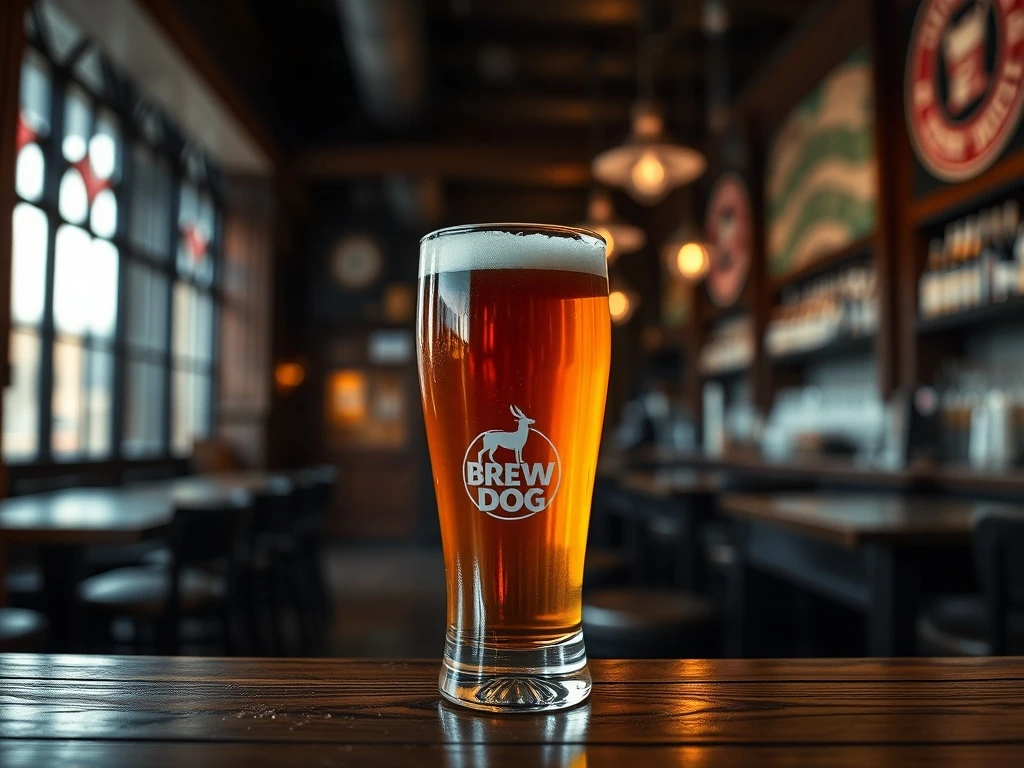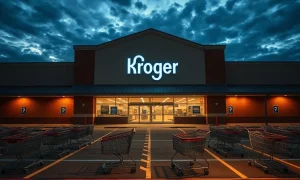BrewDog, once the rebellious darling of the craft beer world, now faces a formidable challenge. Recent figures reveal a staggering withdrawal of its beers from nearly 2,000 pubs across Britain, marking a significant setback for the Scottish brewer. This dramatic decline highlights the intense pressures on the brand, forcing it to battle substantial losses and widespread bar closures. For entrepreneurs and business leaders, the BrewDog story offers crucial insights into market shifts and brand resilience.
The Alarming Decline in BrewDog’s Pub Presence
Confidential industry data paints a stark picture for BrewDog. Over the past two years, the company’s draught beers have vanished from approximately 1,860 pubs across the UK. This represents a substantial reduction, cutting BrewDog’s overall UK distribution by more than a third. Its flagship product, Punk IPA, has suffered the most severe impact. Distribution for Punk IPA has been slashed by over half, as it was dropped from a significant 1,980 pubs during the same period.
An insider from the pub industry recently commented to The Times, stating, “BrewDog is losing taps in the [pub and bar trade] like you wouldn’t believe.” This decline has created opportunities for rival brands. Competitors such as Camden Town and Beavertown are now increasingly occupying the prime tap positions that BrewDog once held. These losses primarily stem from major pub chains and large operators. Consequently, BrewDog has been deprived of vital income streams. This occurs at a critical juncture, as the company simultaneously strives to repair its financial standing and damaged public reputation.
Financial Woes and Strategic Bar Closures for BrewDog
BrewDog’s financial struggles have become increasingly apparent. The company reported substantial losses, reaching £59 million in 2023 and £30.5 million in 2022. These figures underscore the significant financial headwinds the brewer currently faces. James Taylor, who assumed the chief executive role last year, has candidly admitted that BrewDog is expected to remain in the red for the current year. This persistent unprofitability presents a formidable challenge for the leadership team.
In a move reflecting these economic pressures, BrewDog was compelled to shutter 10 of its own branded bars across the UK just last month. This included its prominent flagship site located in Aberdeen. Management declared these locations commercially unviable, signaling a broader reevaluation of the company’s operational footprint. The downturn clearly illustrates the immense challenge confronting CEO Taylor. He inherited a turbulent period characterized by heavy financial losses and serious allegations of a “toxic” workplace culture. Addressing these issues is paramount for BrewDog’s long-term viability.
Navigating a Turbulent Leadership Era at BrewDog
James Taylor’s tenure as chief executive began amidst significant upheaval. He took the helm following a period marked by considerable financial strain and widespread criticism regarding BrewDog’s internal environment. Allegations of a “culture of fear” and an unhealthy workplace pervaded headlines, significantly impacting the brand’s public image. This negative perception can deter both talent acquisition and consumer loyalty. Consequently, restoring trust and morale within the organization became an immediate priority for Taylor.
His leadership transition followed James Arrow and original co-founder James Watt. Taylor, a former fashion executive, brings a different perspective to the brewing industry. He has already overseen a major rebrand of BrewDog’s beer range. This strategic move aims to inject new momentum and appeal into the product line. However, the ongoing shrinking pub distribution and sustained financial losses present a formidable obstacle. Reversing these trends requires more than just a cosmetic overhaul; it demands fundamental operational and strategic shifts to regain market share and profitability for BrewDog.
The Critical JD Wetherspoon Partnership for BrewDog’s Future
Industry figures highlight BrewDog’s increasingly critical reliance on JD Wetherspoon. This major pub chain, with its 794 pubs, now accounts for a substantial share of BrewDog’s remaining UK distribution. For many independent brewers, securing a deal with a large chain like Wetherspoon is a significant achievement. However, for BrewDog, this partnership has evolved into a cornerstone of its pub presence.
One industry source issued a stark warning: “If they ever lost the JD Wetherspoon deal, then that’s Punk IPA done as a [pub trade] product.” This statement underscores the precarious position BrewDog finds itself in. A termination of this agreement could effectively eliminate its flagship beer from a vast number of pubs overnight. Therefore, maintaining this crucial relationship is paramount for BrewDog to retain any significant footprint in the traditional pub trade. It represents a vital lifeline amidst broader distribution challenges.
Wider Industry Pressures and BrewDog’s Strategic Pivot
Lauren Carroll, BrewDog’s chief operating officer, contextualized the contraction within a broader industry trend. She stated, “Independent brewers across the board have felt the squeeze from the economic pressures hitting the pub trade.” This perspective suggests that BrewDog’s challenges are not entirely unique but rather symptomatic of a tougher operating environment for the entire sector. Rising costs for ingredients, energy, and labor, combined with consumers increasingly watching their discretionary spending, have created a difficult landscape.
Pub groups, facing their own financial constraints, have responded by narrowing their beer ranges. They often prioritize established, high-volume brands or focus more heavily on their own house brands. Carroll emphasized, “It’s not just us – every independent brewer has been affected.” Recognizing this trend, BrewDog has strategically shifted its focus. The company now aims for “high-impact channels” such as festivals, stadiums, and independent venues. This pivot seeks to compensate for lost pub distribution and connect directly with consumers in alternative settings, hoping to maintain brand visibility and sales for BrewDog.
BrewDog’s Controversial Past and Compounding Financial Pressures
Founded in 2007 by James Watt and Martin Dickie, BrewDog initially built its formidable reputation on audacious marketing stunts and the runaway success of hoppy beers like Punk IPA. The brand cultivated an image of a disruptive, anti-establishment craft brewer. However, recent years have been overshadowed by a series of damaging controversies. These range from the aforementioned allegations of a “culture of fear” within the workplace to significant criticism over a 2017 deal.
This particular deal involved US private equity firm TSG Consumer Partners. The terms of this agreement are particularly stringent, requiring BrewDog to deliver an 18 percent compounding return on TSG’s shares. This clause places immense and escalating pressure on BrewDog’s finances. Furthermore, it has sparked considerable concern among its thousands of small “Equity Punk” investors. These loyal crowdfunding supporters feel their investments are increasingly at risk due to the company’s financial obligations and declining performance. The compounding return requirement makes financial recovery even more challenging for BrewDog.
Rebranding Efforts and an Uncertain Future for BrewDog
James Taylor, having succeeded both James Watt and James Arrow as chief executive, has spearheaded a significant rebrand of BrewDog’s beer range. This initiative represents a clear attempt to restore momentum and refresh the brand’s appeal in a highly competitive market. A rebrand often aims to signal a new direction, a renewed commitment to quality, or a departure from past controversies. For BrewDog, it likely seeks to achieve all these objectives.
However, the effectiveness of this rebrand remains to be seen. With persistent shrinking pub distribution and ongoing substantial losses, BrewDog faces an undeniable uphill battle. The company must not only regain lost market share but also rebuild its reputation among consumers and industry partners. Reclaiming its once-prominent place at the bar, both literally and figuratively, will require sustained effort, strategic innovation, and a robust financial turnaround. The future trajectory of BrewDog hinges on its ability to navigate these multifaceted challenges successfully.
BrewDog’s journey from a craft beer phenomenon to a brand battling significant losses and declining pub presence serves as a cautionary tale for the business world. The challenges are complex, encompassing financial strain, reputational damage, and intense market competition. While strategic pivots towards new channels offer some hope, the reliance on key partnerships and the pressure from past financial agreements underscore the fragility of its current position. BrewDog’s fight to reclaim its former glory is far from over, and its path forward will be closely watched by the entire industry.
Frequently Asked Questions (FAQs) about BrewDog
Why is BrewDog losing its presence in pubs?
BrewDog is experiencing a decline in pub distribution due to a combination of factors. These include broader economic pressures affecting the pub trade, pub groups narrowing their beer ranges, increased competition from rival brands like Camden Town and Beavertown, and internal financial struggles.
How much money has BrewDog lost recently?
BrewDog reported significant financial losses in recent years. The company recorded losses of £59 million in 2023 and £30.5 million in 2022. The current CEO anticipates the company will remain unprofitable this year.
What is the “toxic culture” controversy associated with BrewDog?
The “toxic culture” controversy refers to allegations from former employees regarding a challenging and at times unhealthy workplace environment within BrewDog. Reports described a “culture of fear” and criticized the leadership style of its co-founder, James Watt.
Is BrewDog’s flagship Punk IPA still widely available?
While Punk IPA’s distribution in pubs has significantly decreased, being dropped from nearly 2,000 pubs, it is still available. BrewDog maintains a critical partnership with JD Wetherspoon and is also shifting focus to high-impact channels like festivals, stadiums, and independent venues.
Who is the current CEO of BrewDog, and what are their plans?
James Taylor is the current chief executive of BrewDog. He took over in 2024 and is tasked with navigating the company through its financial difficulties and reputational challenges. Taylor has overseen a major rebrand of the beer range and is focusing on diversifying distribution channels beyond traditional pubs.
What impact does the TSG Consumer Partners deal have on BrewDog?
The 2017 deal with US private equity firm TSG Consumer Partners requires BrewDog to deliver an 18 percent compounding return on TSG’s shares. This agreement places substantial financial pressure on BrewDog, affecting its profitability and raising concerns among its small “Equity Punk” investors due to the escalating financial obligations.






